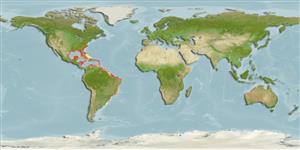Ikan bertulang rawan (sharks and rays) >
Carcharhiniformes (Ground sharks) >
Carcharhinidae (Requiem sharks)
Etymology: Carcharhinus: karcharos (Gr.), sharp or jagged; rhinus, an ancient name for sharks, from rhine (Gr.), rasp, both words alluding to a shark's jagged, rasp-like skin. (See ETYFish); acronotus: acro-, from akron (Gr.), top, summit or peak; notus, from notos (Gr.), back, allusion not explained, perhaps referring to “raised” (translation) back at first dorsal fin. (See ETYFish).
More on author: Poey.
Environment: milieu / climate zone / depth range / distribution range
Ekologi
laut berasosiasi dengan karang; kisaran kedalaman 9 - 64 m (Ref. 50072), usually 9 - ? m (Ref. 55176). Subtropical; 40°N - 37°S, 100°W - 33°W (Ref. 55176)
Western Atlantic: North Carolina, USA to southern Brazil and Uruguay (Ref. 58839), including the Gulf of Mexico and the Caribbean.
Length at first maturity / Size / Weight / umur
Maturity: Lm 110.7, range 87 - 137 cm
Max length : 200 cm TL jantan/; (Ref. 244); Berat maksimum terpublikasi: 18.9 kg (Ref. 40637); Umur maksimum dilaporkan: 20 Tahun (Ref. 108669)
Found on continental and insular shelves, mainly over sandy, shell, and coral bottoms. Feeds on small fishes, including pinfish (Sparidae) and porcupine fish. Preyed on by larger sharks. Viviparous (with a yolk-sac placenta), with 3 to 6 young per litter. Performs a 'hunch' display, with back arched, caudal lowered and head raised, as a possible threat display when confronted by divers. Utilized dried salted for human consumption. Minimum depth from Ref. 055176.
Viviparous, placental (Ref. 50449), with 3 to 6 young per litter (Ref. 244). Distinct pairing with embrace (Ref. 205).
Compagno, L.J.V., 1984. FAO Species Catalogue. Vol. 4. Sharks of the world. An annotated and illustrated catalogue of shark species known to date. Part 2 - Carcharhiniformes. FAO Fish. Synop. 125(4/2):251-655. Rome: FAO. (Ref. 244)
Status IUCN Red List (Ref. 130435)
penggunaan manusia
Perikanan: nilai komersial kecil; Ikan buruan: ya
Alat, peralatan
laporan khas
muat turun XML
Sumber internet
Estimates based on models
Preferred temperature (Ref.
123201): 22.2 - 28, mean 25.5 °C (based on 520 cells).
Phylogenetic diversity index (Ref.
82804): PD
50 = 0.5000 [Uniqueness, from 0.5 = low to 2.0 = high].
Bayesian length-weight: a=0.00479 (0.00221 - 0.01036), b=3.09 (2.92 - 3.26), in cm total length, based on LWR estimates for this Genus-body shape (Ref.
93245).
Trophic level (Ref.
69278): 4.4 ±0.5 se; based on diet studies.
Daya lenting (Ref.
120179): Rendah, Waktu penggandaan populasi minimum 4.5 - 14 tahun (K=0.12; tm=3; tmax=15; Fec=4).
Prior r = 0.44, 95% CL = 0.29 - 0.66, Based on 1 full stock assessment.
Fishing Vulnerability (Ref.
59153): High vulnerability (60 of 100).
Nutrients (Ref.
124155): Calcium = 4.6 [0.8, 24.8] mg/100g; Iron = 0.382 [0.095, 1.094] mg/100g; Protein = 23 [20, 25] %; Omega3 = 0.156 [0.059, 0.385] g/100g; Selenium = 13.2 [4.0, 40.1] μg/100g; VitaminA = 34.1 [11.8, 102.7] μg/100g; Zinc = 0.367 [0.171, 0.718] mg/100g (wet weight);
